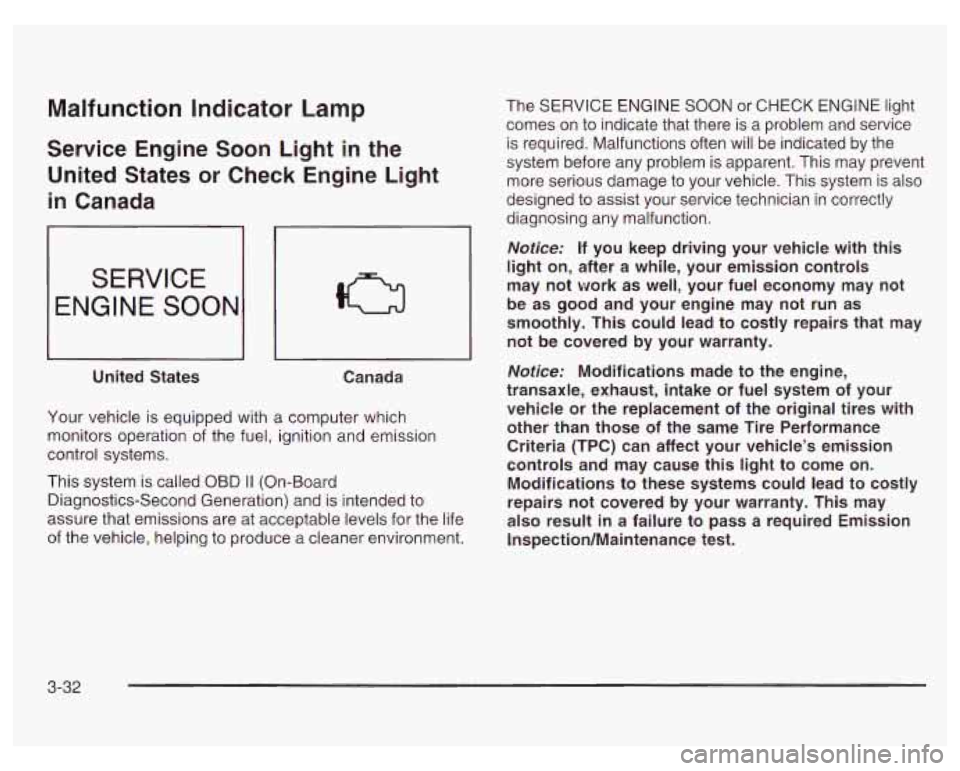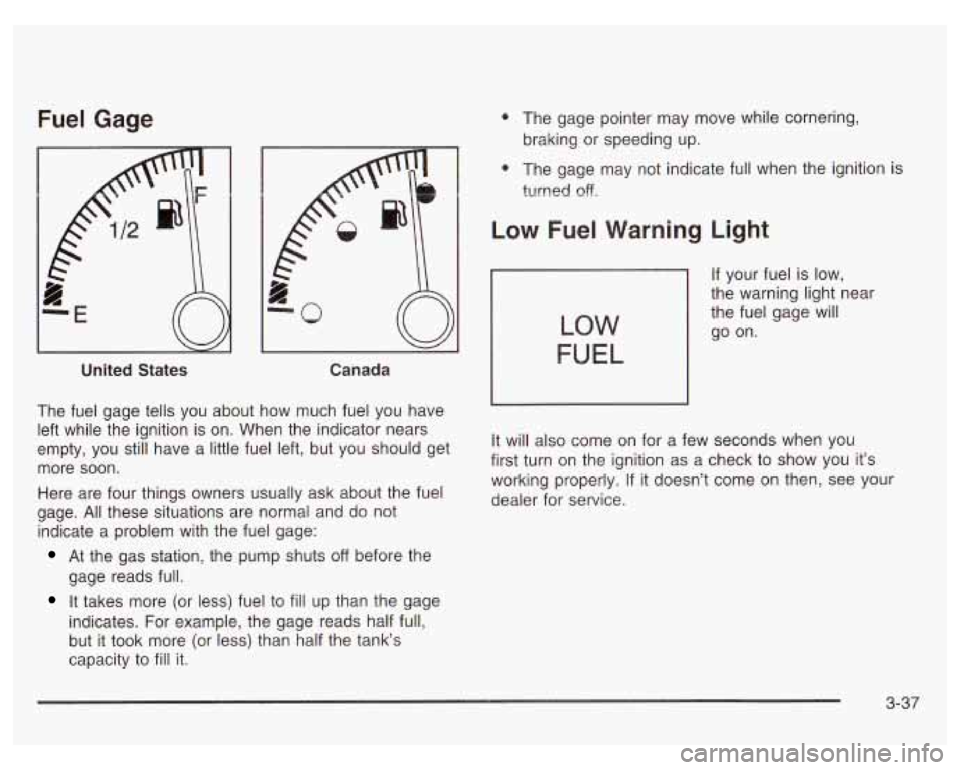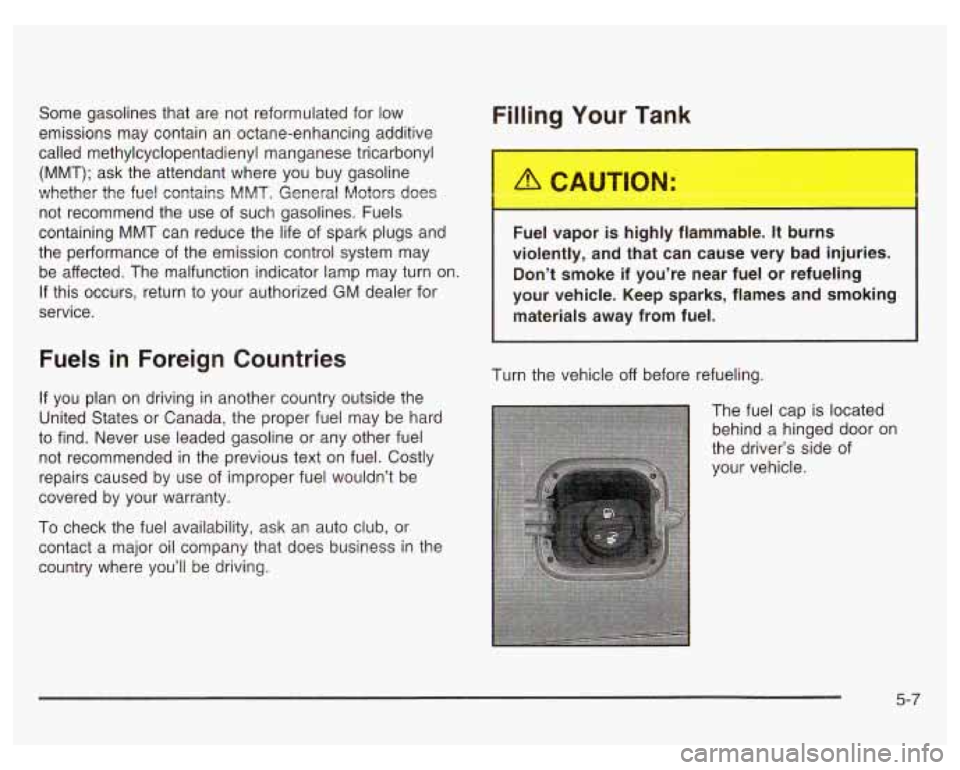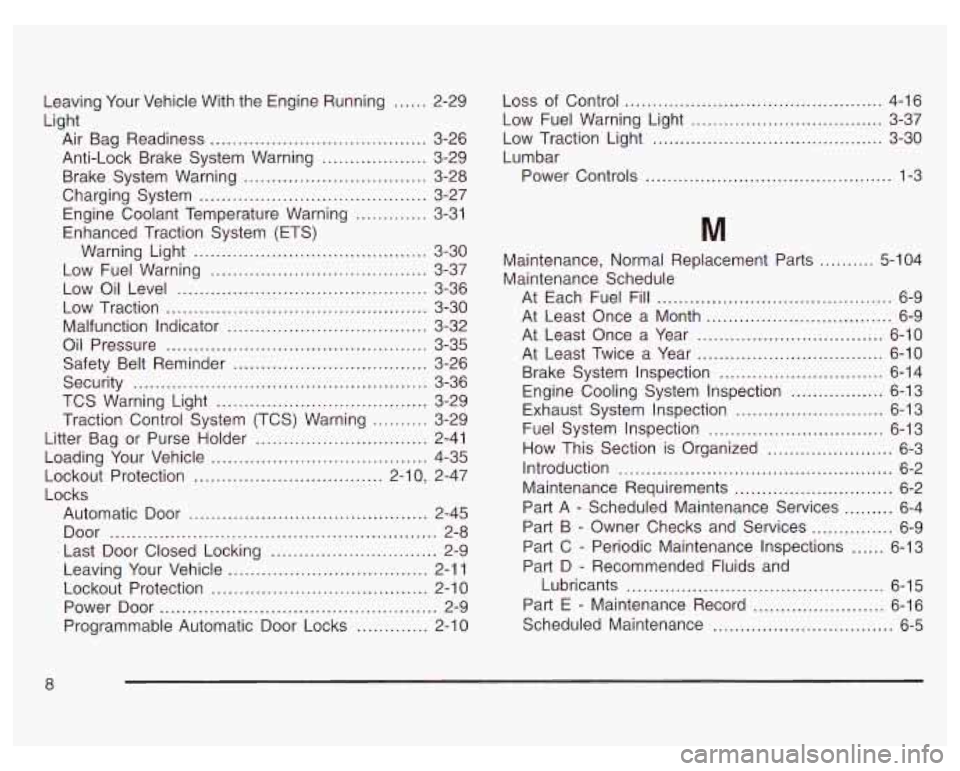2003 PONTIAC GRAND PRIX service indicator
[x] Cancel search: service indicatorPage 2 of 378

The 2003 Pontiac Grand Prix Owner Manual a
Seats and Restpaint Systems ........................... ? -1
Front Seats ............................................... 1-2
Safety Belts
.............................................. 1-7
Child Restraints
....................................... 1-29
Supplemental Restraint System
(SRS) ......... 1-51
Restraint System Check
............................ 1-58
Keys
........................................................ 2-3
Doors and Locks
....................................... 2-8
Windows
................................................. 2-1 3
Theft-Deterrent Systems
............................ 2-1 5
Starting and Operating Your Vehicle
........... 2-19
Mirrors
.................................................... 2-33
Onstar@ System
...................................... 2-38
Storage Areas
......................................... 2-40
Sunroof
.................................................. 2-42
Vehicle Personalization
............................. 2-43
Instrument Panel Overview
.......................... 3-2
Climate Controls
...................................... 3-20
Warning Lights, Gages and Indicators
......... 3-23
Driver Information Center (DIC)
.................. 3-38
Trip Computer
......................................... 3-40
Audio System(s)
....................................... 3-44
Features and Controls ..................................... 2-1
Instrument Panel ............................................. 3-1
~rivingi yoerr Vehicle ....................................... 4-1
Your Driving, the Road, and Your Vehicle
..... 4-2
Towing
................................................... 4-33
Service
..................................................... 5-3
Fuel
......................................................... 5-5
Checking Things Under the Hood
............... 5-10
Headlamp Aiming
..................................... 5-59
Bulb Replacement
.................................... 5-60
Windshield Wiper Blade Replacement
......... 5-67
Tires
...................................................... 5-68
Appearance Care
..................................... 5-88
Vehicle Identification
................................. 5-96
Electrical System
...................................... 5-97
Capacities and Specifications
................... 5-1 02
Normal Maintenance Replacement Parts .... 5-1 04
Maintenance Schedule ........................... ,6-1 ..
Maintenance Schedule ................................ 6-2
Customer Assistance Information .................... 7-1
Customer Assistance Information
.................. 7-2
Service and Appearance Care .......................... 5-1
Reporting Safety Defects
......................... 7-9
Index ........................................ ..... 1
Page 87 of 378

Notice: If your key seems stuck in LOCK and you
can’t turn it, be sure you are using the correct key;
if
so, is it all the way in? Turn the key only with
your hand. Using a tool to force it could break the
key or the ignition switch. If none
of these works,
then your vehicle needs service.
B (LOCK): This position locks the ignition, steering
wheel and transaxle. It’s a theft-deterrent feature. It’s also
the only position from which you can remove the key.
C (OFF): This position lets you turn off the engine but
still turn the steering wheel. It doesn’t lock the
steering wheel like LOCK. Use
OFF if you must have
the vehicle pushed or towed.
D (RUN): This position is where the key returns to after
you start the vehicle. With the engine
off, you can use
RUN to display some of the warning and indicator lights.
E (START): This position starts the engine.
A warning chime will sound
if you open the driver’s door
while the ignition is in
OFF, LOCK or ACCESSORY
and the key is in the ignition.
Retained Accessory Power (RAP)
With Retained Accessory Power, (RAP), the power
windows, audio system and sunroof will continue to work
up to
10 minutes after the ignition key is turned to
OFF and none of the doors are opened.
Starting Your Engine
Move your shift lever to PARK (P) or NEUTRAL (N).
Your engine won’t start in any other position - that’s a
safety feature. To restart while you’re already moving,
use NEUTRAL
(N) only.
Nofice: Don’t try to shift to PARK (P) if your
vehicle is moving.
If you do, you could damage the
transaxle. Shift to
PARK (P) only when your
vehicle is stopped.
Shift Lock Release
This vehicle is equipped with an electric shift lock
release system. The shift lock release is designed to
do the following:
Prevent ignition key removal unless the shift lever is
in PARK (P) with the shift lever button fully released.
Prevent movement of the shift lever out of PARK (P)
unless the ignition is in a position other than
OFF or
LOCK. The shift lock release is always functional
except in the case
of a dead or low voltage
(less than
9 V) battery.
2-20
Page 153 of 378

Malfunction indicator Lamp
Service Engine Soon Light in the
United States or Check Engine Light
in Canada
SERVICE
ENGINE SOON
United States
~~
Canada
Your vehicle is equipped with a computer which
monitors operation of the fuel, ignition and emission
control systems.
This system is called
OBD II (On-Board
Diagnostics-Second Generation) and is intended to
assure that emissions are at acceptable levels for the life
of the vehicle, helping to produce a cleaner environment. The SERVICE ENGINE SOON
or CHECK ENGINE
light
comes on to indicate that there is a problem and service
is required. Malfunctions often will be indicated by the
system before any problem is apparent. This may prevent
more serious damage
to your vehicle. This system is also
designed to assist your service technician in correctly
diagnosing any malfunction.
Notice: If you keep driving your vehicle with this
light
on, after a while, your emission controls
may not work as well, your fuel economy may not
be as good and your engine may not run as
smoothly. This could lead to costly repairs that may
not be covered by your warranty.
Notice: Modifications made to the engine,
transaxle, exhaust, intake or fuel system of your
vehicle or the replacement
of the original tires with
other than those
of the same Tire Performance
Criteria (TPC) can affect your vehicle’s emission
controls and may cause this light to come on.
Modifications to these systems could lead to costly
repairs not covered by your warranty. This may
also result
in a failure to pass a required Emission
Inspection/Maintenance test.
3-32
Page 158 of 378

Fuel Gage
United States Canada
The fuel gage tells you about how much fuel you have
left while the ignition is on. When the indicator nears
empty, you still have a little fuel left, but you should get
more soon.
Here are four things owners usually ask about the fuel
gage.
All these situations are normal and do not
indicate a problem with the fuel gage:
At the gas station, the pump shuts off before the
gage reads full.
It takes more (or less) fuel to fill up than the gage
indicates. For example, the gage reads half full,
but it took more (or less) than half the tank‘s
capacity to
fill it.
0 The gage pointer may move while cornering,
braking or speeding up.
0 The gage may not indicate full when the ignition i?
turned off.
Low Fuel Warning Light
If your fuel is low,
the warning light near
the fuel gage will
go on.
LOW
FUEL
It will also come on for a few seconds when you
first turn on the ignition as a check to show you it’s
working properly.
If it doesn’t come on then, see your
dealer for service.
3-37
Page 232 of 378

Some gasolines that are not reformulated for low
emissions may contain an octane-enhancing additive
called methylcyclopentadienyl manganese tricarbonyl
(MMT); ask the attendant where you buy gasoline
whether the fuel contains MMT. General Motors does
not recommend the use of such gasolines. Fuels
containing MMT can reduce the life of spark plugs and
the performance of the emission control system may
be affected. The malfunction indicator lamp may turn on
If this occurs, return to your authorized GM dealer for
service.
Fuels in Foreign Countries
If you plan on driving in another country outside the
United States or Canada, the proper fuel may be hard
to find. Never use leaded gasoline or any other fuel
not recommended in the previous text on fuel. Costly
repairs caused by use of improper fuel wouldn’t be
covered by your warranty.
To check the fuel availability, ask an auto club, or
contact a major oil company that does business in the
country where you’ll be driving.
Filling Your Tank
Fuel \-$or is highly flammable. .. mrns
violently, and that can cause very bad injuries.
Don’t smoke
if you’re near fuel or refueling
your vehicle. Keep sparks, flames and smoking
materials away from fuel.
Turn the vehicle off before refueling.
The fuel cap is located
behind a hinged door on
the driver’s side
of
your vehicle.
5-7
Page 367 of 378

Leaving Your Vehicle With the Engine Running ...... 2-29
Air Bag Readiness
....................................... 3-26
Anti-Lock Brake System Warning
................... 3-29
Brake System Warning
................................. 3-28
Engine Coolant Temperature Warning
............. 3-31
Warning Light
.......................................... 3-30
Low Fuel Warning
....................................... 3-37
Light
Charging System
......................................... 3-27
Enhanced Traction System (ETS)
Low Oil Level
............................................. 3-36
Low Traction
............................................... 3-30
Malfunction Indicator
.................................... 3-32
Oil Pressure
............................................... 3-35
Safety Belt Reminder
................................... 3-26
Security
..................................................... 3-36
TCS Warning Light
...................................... 3-29
Traction Control System (TCS) Warning
.......... 3-29
Loading Your Vehicle
....................................... 4-35
Litter
Bag or Purse Holder
............................... 2-41
Lockout Protection
.................................. 2-10, 2-47
Locks
Automatic Door
........................................... 2-45
Door
........................................................... 2-8
Last Door Closed Locking
.............................. 2-9
Lockout Protection
....................................... 2-1 0
Power Door .................................................. 2-9
Programmable Automatic Door Locks
............. 2-1 0
Leaving Your Vehicle .................................... 2-1 1 Loss
of Control
.............................................. 4-16
Low Fuel Warning Light
................................... 3-37
Low Traction Light
...................................... 3-30
Lumbar Power Controls
........... ........... ... 1-3
M
Maintenance. Normal Replacement Parts .......... 5-1 04
Maintenance Schedule At Each Fuel Fill
........................................... 6-9
At Least Once a Month
.................................. 6-9
At Least Once a Year
.................................. 6-10
At Least Twice a Year
.................................. 6-10
Brake System Inspection
.............................. 6-14
Engine Cooling System Inspection
................. 6-13
Exhaust System Inspection
........................... 6-13
How This Section is Organized ....................... 6-3
Introduction
.................................................. 6-2
Maintenance Requirements
............................. 6-2
Part A
- Scheduled Maintenance Services ......... 6-4
Part B
- Owner Checks and Services ............... 6-9
Part C
- Periodic Maintenance Inspections ...... 6-13
Part D
- Recommended Fluids and
Lubricants
............................................... 6-15
Part E
- Maintenance Record ........................ 6-16
Scheduled Maintenance
................................. 6-5
Fuel
System Inspection
................................ 6-13
a
Page 368 of 378

Maintenance Schedule (cont.) Steering. Suspension and Front Drive Axle
Boot and Seal Inspection .......................... 6-13
Throttle System Inspection ............................ 6-1 4
Your Vehicle and the Environment ................... 6-2
Maintenance When Trailer Towing ..................... 4-43
Making Turns ................................................. 4-41
Malfunction Indicator Light ................................ 3-32
Manual Seats ................................................... 1-2
Matching Transmitter(s) to Your Vehicle ............... 2-6
Mexico, Central America and Caribbean
Using
Your
................................................... 6-4
Islands/Countries
(Except Puerto Rico and
U.S. Virgin Islands) ....... 7-4
Mirror Operation ..................................... 2-33, 2-35
Mirrors Automatic Dimming Rearview with Compass
Automatic Dimming Rearview with Onstar@,
Manual Rearview Mirror
................................ 2-33
Outside Convex Mirror ................................. 2-37
Outside Power Mirrors .................................. 2-37
and Temperature Display ........................... 2-34
Compass and Temperature Display ............. 2-33
New Vehicle Break-In ............................ ... 2-19
Normal Maintenance Replacement Parts ........... 5-1 04
0
Odometer ...................................................... 3-25
Off-Road Recovery .......................................... 4-15
Oil
Engine .................................... .... 5-18
Low Oil Level Light ...................................... 3-36
Pressure Light ............................................. 3-35
Supercharger, Engine ................................... 5-24
Older Children, Restraints ................................ 1-29
Onstar@ Personal Calling ................................. 2-39
Onstar@ Services ............................................ 2-38
Onstat-@ System ............................................. 2-38
Onstar@ Virtual Advisor .................................... 2-39
Other Warning Devices ...................................... 3-4
Outlet Adjustment ............................................ 3-22
Outside
Convex Mirror
............................................. 2-37
Power Mirrors ............................................. 2-37
Overhead Console .......................................... 2-40
Overhead Console Reading Lamps .................... 3-14
Overheated Engine Protection
Operating Mode
.......................................... 5-33
Owners, Canadian ............................................... ii
Owner’s Information ........................................ 7-10
9
Page 374 of 378

Vehicle Identification
Number (VIN)
............................................. 5-96
Service Parts Identification Label
................... 5-96
Vehicle Personalization .................................... 2-43
Arming and Disarming the Content
Theft-Deterrent System
............................. 2-52
Automatic Door Locks
.................................. 2-45
Content Theft-Deterrent System
..................... 2-51
Delayed Illumination and Exit Lighting
............. 2-44
Entering Programming Mode
......................... 2-44
Exiting Programming Mode
........................... 2-53
Last Door Closed Locking and Lockout
Protection
............................................... 2-47
Remote Driver Unlock Control
....................... 2-48
Remote Lock and Unlock Confirmation
........... 2-49
Vehicle Storage
.............................................. 5-53
Ventilation Adjustment
...................................... 3-22
Vinyl
............................................................. 5-90
Visor Vanity Mirror
.......................................... 2-14
Visors
.............................. .............. 2-14
Warning Lights. Gages and Indicators
................ 3-23
Hazard Warning Flashers
............................... 3-3
Other Warning Devices
.................................. 3-4
Warnings Warnings
(cont.)
...
Safety and Symbols ......................................... III
Vehicle Damage .............................................. iv
Washing Your Vehicle
...................................... 5-91
Weatherstrip Lubrication ................................... 6-10
Weight of the Trailer
........................................ 4-38
Weight of the Trailer Tongue
............................. 4-39
What Kind of Engine
Oil to Use ........................ 5-20
What Kind of
Oil to Use .................................. 5-24
What to Do with Used Oil
................................ 5-24
What to Use
.................................. 5-30, 5-47, 5-48
Wheels Alignment and Tire Balance
.......................... 5-73
When to Add Engine Oil
.................................. 5-19
When to Change Engine Oil
(GM Oil Life SystemTM) ................................ 5-23
When to Check
...................................... 5-24, 5-69
When to Check and Change
............................ 5-27
When to Check Power Steering Fluid
................ 5-47
When You Are Ready to Leave After
Parking on a Hill
......................................... 4-43
Where to Put the Restraint
............................... 1-38
Window Lock-Out
............................................ 2-14
Windows
....................................................... 2-13
Power
........................................................ 2-14
Windshield and Wiper Blades
....................... 5-92
Replacement
............................................... 5-73
Why Safety Belts Work
..................................... 1-8
15